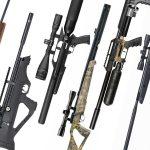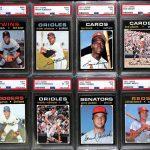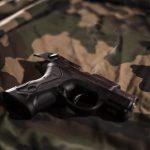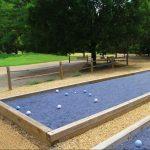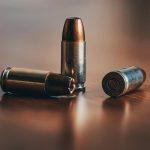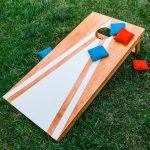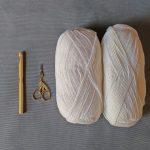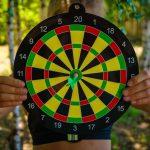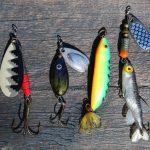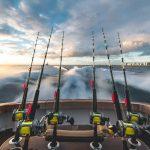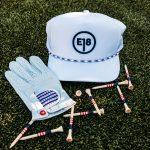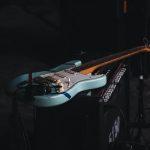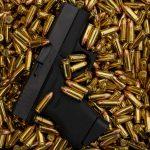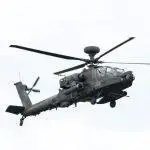Bullet Size Guide : What are the sizes of bullets ?
Bullets come in a wide range of sizes, from small caliber cartridges to giant shells. The most popular bullet size is .22, used for handguns and rifles. Other common smaller sizes for pistols include 9mm and .45, and for rifles the 5.56 and 7.62 are popular choices. Bullets may be up to 3” in length for larger firearms such as shotguns. Each type of gun will require specific bullet sizes based on its mechanism; discover them all in the below bullet size chart.

Modern era bullets consist of a cartridge case with the bullet affixed at the front end, the percussion cap or primer at the base, and the propellant powder contained within the tube (skip straight to the bullet size charts).
The diameter and weight show bullet caliber in both metric and imperial measurements for example; a 55 grain .223 caliber bullet is of the same weight and caliber as a 3.56 gram 5.56 mm caliber bullet.
Bullets tips come in various types and designs they are;open-tip bullets, full metal jackets, soft point bullets, ballistic tips, armor-piercing cartridges, hollow point bullets and many more.
Related: Air Gun Size Guide, Paintball Gun size – guns, gear and caliber size chart
Table of content
- Bullet Size Chart: Components of a cartridge
- Bullet size chart with a few examples of matching cartridges
- Most Popular size of bullets with dimensions and usage
- Common bullet caliber and types available
- How to Choose the Right Bullet Size
- Faq on Size of bullets
Bullet Size Chart: Components of a cartridge
A cartridge is an ammunition packaging tool that fits into the gun barrel. Bullets are one of the components of the cartridge others include;
Casing– can either be made of copper, brass or steel and it houses all the other components.The original cartridge case was made up of paper but nowadays they are metallic.
Primer– when the firing pin receives impact it ignites the gun powder dividing it into two types the rimfire cartridge where the primer is located in the rim and the centerfire cartridge where the primer is located at the center.
Propellant– it holds the actual power to fuel any firearm. For it to perform accurately grain size and shape influences the burn rate.
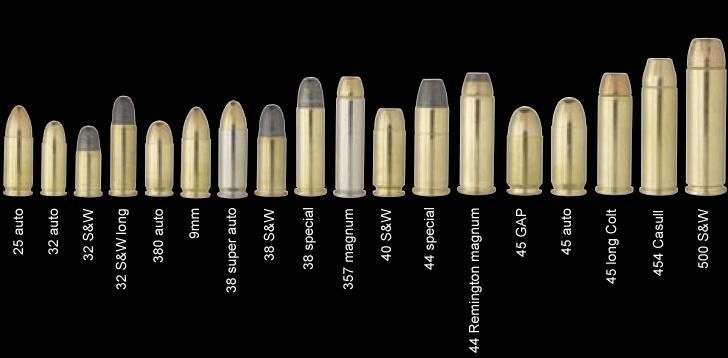
Most Popular size of bullets with dimensions and usage
| Caliber/Bullet Size | Diameter (in) | Diameter (cm) | Length (in) | Length (cm) | Commonly Used In |
|---|---|---|---|---|---|
| .22 LR | 0.222 | 5.64 | 1.000 | 25.4 | Rifles and pistols for target shooting and small game hunting |
| 9mm Luger/Parabellum | 0.355 | 9.02 | 0.754 | 19.15 | Semi-automatic handguns for self-defense, law enforcement, and military applications |
| .45 ACP | 0.452 | 11.5 | 0.898 | 22.8 | Semi-automatic handguns for self-defense and law enforcement |
| .357 Magnum | 0.357 | 9.07 | 1.290 | 32.77 | Revolvers for self-defense and hunting |
| .308 Winchester/7.62x51mm NATO | 0.308 | 7.82 | 2.015 | 51.18 | Rifles for hunting and long-range shooting |
| .223 Remington/5.56x45mm NATO | 0.224 | 5.7 | 1.760 | 44.7 | Rifles for target shooting, varmint hunting, and military applications |
| .30-06 Springfield | 0.308 | 7.82 | 2.494 | 63.3 | Rifles for hunting and long-range shooting |
| .380 ACP | 0.355 | 9.02 | 0.680 | 17.27 | Semi-automatic handguns for concealed carry and self-defense |
| 12 gauge shotgun | 0.729 | 18.5 | 2.750 | 69.85 | Shotguns for hunting, sport shooting, and self-defense |
bullet size chart with a few examples of matching cartridges:
| Cartridge name | Bullet length in inches and millimeters | Case length in inches and millimeters | Cartridge length in inches and millimeters |
| .41 Short Colt | 0.40 inches 10.2 millimeters | 0.65 inches 16.5 millimeters | 0.91 inches 23.1 millimeters |
| 2.7 mm Kolibri (2mm Kolibri, 2.7*9mm) | 0.11 inches 2.7 millimeters | 0.37 inches 9.4 millimeters | 0.43 inches 10.9 millimeters |
| .22 Long Rifle (.22 LR 22 Stinger) | 0.22 inches 5.7 millimeters | 0.59 inches 15.1 millimeters | 0.97 inches 24.8 millimeters |
| .22 Remington Jet (22 Centerfire Magnum) | 0.22 inches 5.7 millimeters | 1.28 inches 32.5 millimeters | 1.58 inches 40.1 millimeters |
| .256 Winchester Magnum | 0.25 inches 6.5 millimeters | 1.3 inches 33.0 millimeters | 1.63 inches 38.9 millimeters |
| 25 ACP (25 Auto Colt Pistol, 6.35 Browning) | 0.25 inches 6.4 millimeters | 0.62 inches 15.7 millimeters | 0.91 inches 23.1 millimeters |
| 7.62mm Tokarev (7.62*25mm) | 0.31 inches 7.8 millimeters | 0.97 inches 24.6 millimeters | 1.35 inches 34.3 millimeters |
| .32 S&W | 0.31 inches 7.9 millimeters | 0.61 inches 15.5 millimeters | 0.92 inches 23.4 millimeters |
| .32 H&R Magnum | 0.31 inches 7.9 millimeters | 1.08 inches 27.4 millimeters | 1.35 inches 34.3 millimeters |
| 9mm Japanese revolver (9*22mmR Type 26) | 0.35 inches 8.9 millimeters | 0.86 inches 21.8 millimeters | 1.21 inches 30.7 millimeters |
| 9mm Parabellum(9*19mm Luger, 9mm NATO) | 0.35 inches 9.0 millimeters | 0.75 inches 19.2 millimeters | 1.17 inches 29.7 millimeters |
| .38 ACP(38 Auto, 9*23mmSR | 0.36 inches 9.1 millimeters | 0.9 inches 22.9 millimeters | 1.28 inches 32.5 millimeters |
Common bullet caliber and types available
A gun caliber is the internal diameter of a barrel in addition with the diameter of the bullet. Its measurement consists of inches and millimeters.
Moreover, the most popular caliber is the 9-millimeter measurement which has the recoil at very low proximites and its usually preferred by many guns. Other variety of calibers are; .380 ACP, 40 S&W, .45 ACP and many others.
Other firearm calibers are the shotgun caliber and rifle caliber. In addition the shotgun caliber entails of three gauges. The 12-gauge shotgun is the most popular caliber round and has a larger barrel diameter than the 20-gauge shotgun. Equally important is the word gauge is termed as bore in the UK therefore we can say “12 bore shotgun’.
Rifles are housed in a variety of calibers with the lowest measurement being 4.4 mm and the highest is 20 mm which entails the anti-tank rifle. With the development of series of rifles other calibers emerged and the most popular being the .22 long rifle which is beginner friendly and can be used by used due to its low recoil, others stated are .30-30 Winchester – which is a golden age centerfire smokeless cartridge introduced in the year 1895 and its associated with lever-action rifles, .30-06 springfield- it has an accurate kill shot living no animal alive due to its power range and popular bolt action hunting round and many more.
Below is a table illustrating the common calibers in inch and their metric equivalents:
| Caliber | Metric caliber in (millimeters and inches) | Typical bullet diameter in inches and millimeters |
| 172 | 4 millimeters 0.157 inches | 0.172 inches 4.37 millimeters |
| 20, 204 | 5 millimeters 0.1969 inches | 0.204 inches 5.18 millimeters |
| 221 | 5.45 millimeters 0.2146 inches | 0.221 inches 5.61 millimeters |
| 22 | 5.6 millimeters 0.2205 inches | 0.223 inches 5.66 millimeters |
| 224 | 5.7 millimeters 0.2244 inches | 0.224 inches 5.69 millimeters |
| 243 | 6 millimeters 0.2362 inches | 0.243 inches 6.17 millimeters |
| 25 | 6.35 millimeters 0.25 inches | 0.257 inches 6.35 millimeters |
| 26 | 6.5 millimeters 0.2559 inches | 0.264 inches 6.7 millimeters |
| 27 | 6.8 millimeters 0.2677 inches | 0.277 inches 7.035 millimeters |
| 284 | 7 millimeters 0.2756 inches | 0.284 inches 7.213 millimeters |
| 308 | 7.62 millimeters 0.3 inches | 0.308 inches 7.82 millimeters |
| 311 | 7.9 millimeters 0.3110 inches | 0.311 inches 7.92 millimeters |
| 312 | 7.94 millimeters 0.3126 inches | 0.312 inches 7.94 millimeters |
| 323 | 8 millimeters 0.3149 inches | 0.323 inches 8.20 millimeters |
| 338 | 8.6 millimeters 0.3385 inches | 0.338 inches 8.58 millimeters |
| 355 | 9 millimeters 0.3543 inches | 0.355 inches 9.01 millimeters |
| 356 | 9 millimeters 0.3543 inches | 0.356 inches 9.04 millimeters |
| 357 | 9 millimeters 0.3543 inches | 0.357 inches 9.07 millimeters |
| 363 | 9 millimeters 0.3543 inches | 0363 inches 9.22 millimeters |
| 365 | 9.3 millimeters 0.3661 inches | 0.365 inches 9.27 millimeters |
| 375 | 9.5 millimeters 0.374 inches | 0.375 inches 9.53 millimeters |
| 40 | 10 millimeters 0.393 inches | 0.400 inches 10.16 millimeters |
| 44 | 10.9 millimeters 0.429 inches | 0.429 inches 10.89 millimeters |
| 45 | 11.43 millimeters 0.45 inches | 0.451-0.454 inches 11.46-11.53 millimeters |
| 50 | 12.7 millimeters 0.5 inches | 0.510 inches 12.95 millimeters |
Ammunition size comparison (video)
How to Choose the Right Bullet Size
Related: Gun Sizes
Bullet sizes are determined by measuring the diameter of the bore from one part to the opposite and its measurement is expressed in millimeters, hundredths of an inch, and thousandths of an inch, for example, a 223 caliber rifle has a smaller bore diameter compared to a 270 caliber rifle bore. Specific cartridges are manufactured to match every handgun or rifle.
To know the right bullet weight for you first, you need to know what unit of measurement is used and it’s called a grain (1 pound is equal to 7000 grains). Once you can identify the weight of the bullet, then with any given load you can know if it falls on the lighter end of the heavier end of the spectrum. Therefore one can choose their favorite bullet size/caliber with the availability of bullet weight.
The best bullet size for you
Getting to match the right bullet with the gun of your choice has not been an easy task for the past years due to the increase in bullet sizes and cartridge dimensions.
Nonetheless, nowadays a lot of people use their firearms for the same reasons like sporting events, hunting purposes, or self-defense therefore one can get what fits their needs from the caliber list items.
More about Bullet Size explained (video)
Conclusion
Law enforcement agencies should be vigilant and educate the masses on gun maintenance and gun safety to prevent fatal injuries caused by bullets. The cranial gunshot wound is one of the deadliest firearm injuries since it is on the head therefore chances of survival are minimal.
Findings show that shootings from larger caliber firearms are considered more hazardous than smaller caliber firearms due to the wound size it leaves. Fortunately, with modern advancements, the bullet indent marker was created so that law enforcers can trace the bullet or cartridge from the weapon it was fired from.
In summary, it is important to practice gun safety wherever to protect yourself and those around you.
If you enjoyed reading this article please don’t hesitate to leave a comment below.
Picture in this post by Velizar Ivanov on Unsplash
Related to Bullet Size Guide
- Air Gun Size Guide
- Ansi Paper Size Chart – North America paper Sizes And Formats
- Baseball Card Size Guide
- Basketball Size Guide
- BB Gun Size and Types of Calibers
- Beer Pong Table Dimensions
- Bocce Ball Court Size and Dimensions
- Bowling Ball Size and Dimensions
- Bullet Size Guide : What are the sizes of bullets ?
- Chessboard Dimensions: What Is The Size Of It?
- Cornhole Board Size and dimensions guide
- Crochet Hook Size Chart – A Handy Conversion Guide
- Dart Board size – dimension and distance
- Dolls Size: What Are the Different Sizes of Dolls?
- Fish Hook Size Chart – All You Need To Know to catch the next fish
- Fishing Gear Size – The Complete Guide
- Fishing Rod Length Guide – The Complete Guide
- Golf Glove Size Chart for Adults & Kids: How to Know the Right Size?
- Guitar Size Chart by Types of Guitars: what size do I need?
- Gun Sizes
- Helicopter Sizes and Different Types
- Hybrid And Fitness Bike Size Chart
- Jet Ski Size: Which Size Should You Go For?

